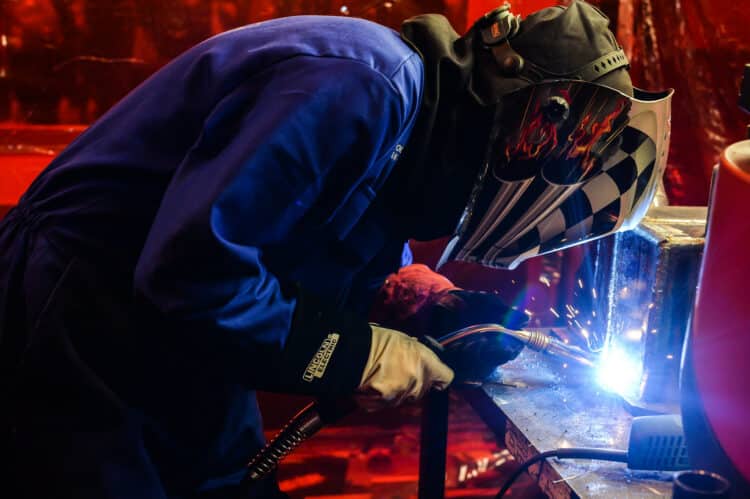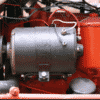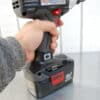
Nothing compares to the divine smell of char-grilled salmon with some roasted herbs and tomatoes cooked up in your favourite cast iron skillet.
While for a glutton like me, a skillet is what the thought of caste iron brings to my mind, it can be used to manufacture a whole host of other useful stuff.
Cast iron is a versatile metal with wide-ranging applications not restricted just to the kitchen.
Most common products of cast iron include pipes, car parts and agricultural equipment.
The question that now arises is what to do if your cast iron product breaks or cracks?
How to repair cast iron?
One common way is to weld it.
Welding is, however, not just a solution for repairs, it helps in manufacturing new products as well.
Welding can daunt anyone who hasn’t done this before, and it is certainly recommended that you contact a professional in case of a complicated repair.
This article intends to equip you with the primary fundamentals of how to weld cast iron.
With sufficient practice and patience, you too can don a welder’s hat!
Table of Contents
What Do You Need To Weld Cast Iron
From a layman’s point of view, welding cast iron would involve the following four items:
• The metal (cast iron in our case) that needs to be welded
• Source of heat like a furnace, heating coil, or electric spark
• Filler liquid that would help bind the separate pieces of metal.
• Air shield to block out excess air.
High temperature, when applied to the affected metal part that needs to be welded, causes it to melt, creating a weld pool. To this, a liquid filler material is added to create a strong bond. As it cools down, the molten metal along with the filler solidifies to combine the separate metal parts into one.
Shielding from the air is necessary to protect against oxidation during the process of welding.
Why Is Cast Iron Welding Difficult
Getting to weld your cast iron without any cracks is no mean feat. For even experienced welders get it right only half the time.
Wondering what makes it difficult to weld?
Cast iron is an alloy made of several elements with a high content of carbon. The carbon-rich content makes it hard and at the same time, brittle. Which means when you subject it to alternate cycles of extreme temperatures, the metal tends to crack instead of bending.
Also, because of the varying ratio of materials that make up cast iron, it becomes tough to gauge the right temperature to heat it without leading the components to start cracking.
What Are The Different Types of Cast Iron
How difficult it would be to weld your cast iron would depend on what variety you have got.
White Iron
If you are thinking of welding white iron, well think again!
Made of iron carbides, this is one of the hardest iron alloy available. It is also very brittle. This makes it very difficult to weld.
Its white colour is derived from carbide that causes cracks all around the metal.
They have however very good resistance to corrosion and is quite cheap. These two qualities, coupled with its high strength, makes it quite popular as a manufacturing metal.
Grey Iron
Grey iron consists of 4% carbon and approx. 3% silicon, among other components. This is very commonly available cast iron.
It is moderately easy to weld and much more ductile compared to its whiter cousin described above! However, welding grey cast iron does come with its share of difficulties.
Grey iron leads to graphite flake formation. If these flakes fall into the molten metal weld pool, that can lead to brittleness in the structure.
Grey iron is usually welded by gas welding.
Ductile Iron
Is ductile iron weldable?
It most definitely is! Let’s find out why!
This type of iron is made from an amalgamation of approximately 94% iron with other elements like carbon, manganese, phosphorus, copper, manganese, sulphur and magnesium.
One can add more copper to make it stronger or some nickel and chromium to increase corrosion resistance.
Ductile iron has excellent resistance and doesn’t break easily. Moreover, due to its composition, it is also easier to expose it to high flames without fear of cracks.
These characteristics make it great for welding; however, the process can be a bit tedious and time-consuming.
Malleable Iron
As the name would suggest, this is a very flexible form of iron that you can bend to any shape you like. White cast iron is subjected to high temperature over a few days to create this kind of iron.
You usually need to stay away from welding malleable iron because on exposing it to further heat, this has a propensity to change its properties altogether.
What kind of welding rod can do you use on cast iron
What’s The Best Way To Weld Cast Iron
Herein we will explore a few available cast iron welding procedures that can help you get your iron welded. It is crucial to keep in mind that each process usually comes with its set of benefits and disadvantages. Which one you will pick will depend on the kind of alloy you have in hand.
How to Weld Using Gas
This can be a very efficient process for welding pipes and tubes. Also, grey cast iron is usually welded by gas welding.
Usually, a mix of oxygen and acetylene is used to light a flame at temperatures above 3000-degree centigrade. The fire is used to soften and melt the metal to be welded.
Copper zinc electrodes and cast iron oxy acetylene welding rods may be used for this kind of welding.
Keep in mind though that oxidation of cast iron can lead your weld to have white iron. Also, make sure to melt the welding rod in the molten metal pool rather than directly introducing to the flame. This helps control drastic changes in temperatures.
Few plus points of gas welding include:
It employs a gradual heating and cooling process which prevents hardening or cracking of metals being welded.
You don’t need electricity for this equipment, making it convenient to move around.
The welder usually gets better control of welding with this process.
Can you weld cast iron with an arc welder
In this kind of welding, electric arc created by electrodes, lead to the process of welding. This constitutes one of the most straightforward welding processes.
The electricity leads to high temperatures of above 6000-degree centigrade Fahrenheit that helps the process of welding by melting the metals and fusing them.
Three main electrodes may be used for this kind of welding:
Copper alloy electrodes
Nickel alloy electrodes
Cast iron covered electrodes
The most popular electrode for this process is one made of a ferronickel alloy.
Can You Weld Cast Iron With MIG Welder
If you have just started learning how to weld, you could try out MIG welding.
You have the welding gun fitted with the MIG cast iron wire. So as you go about welding two pieces of metal, the liquid filler automatically pours out at a set speed on the molten metal surface.
This makes it a much more automated process and hence easier for newbies.
However, welding done this way may not provide a smooth finish.
Keep in mind the best possible filler in this process would be a special nickel wire. However, if that feels too costly, you could opt for a steel wire instead.
How To Weld Using TIG welder
This is a more manual process compared to MIG welding.
Here the caste iron tig wire and the welding torch are separate. So while you use your dominant hand to guide the torch into melting the metal, you have your non-dominant hand to manipulate the filler wire into filling in the molten metal with the binding alloy.
This makes it a somewhat complicated process which needs more concentration and manual dexterity that comes with practice.
Another disadvantage with this process is the limited choice of filler wire when it comes to welding cast iron. The standard go-to option is a nickel wire in TIG welding which makes it quite heavy on the pockets.
The advantages of TIG welding over a MIG one is a better finish and aesthetics. Plus you can use TIG to weld metals without the need for thermal energy, also known as cold welding!
Can Caste Iron Be Brazed
Yes, it can be.
Let’s look at what brazing cast iron is like?
In the standard welding process, high temperature causes the base metals to be welded to melt and mix with the filler liquid to form a join.
However, in brazing, the filler metal is chosen such that it has a lower melting point compared to that of the base metal. So with a high enough temperature, the filler liquefies fast while the metal to be alloyed stays strong. Once the heat is taken away, the filler solidifies gradually thereby binding the pieces of metals together.
For brazing, you will need heating materials like a furnace or an induction coil with sufficient air and flammable gas supply, including nitrogen, hydrogen and ammonia.
What Kind Of Welding Rod Do You Use on Cast Iron
Pure Nickel
This is undoubtedly the best stick rod for welding cast iron.
Benefits of using nickel rods include their pliability and resistance to extreme temperature.
However, unamalgamated nickel is always very expensive. Plus they are not suited for merging thick pieces of metals.
Nickel and Iron Alloy
This is a popular option for welding cast iron.
You can use these electrodes without preheating them.
For best results though, you can heat them to 40 degree centigrade.
This alloy has high ductility and doesn’t become brittle. High nickel content also increases resistance to corrosion and cracking. So the welded metal you get is much stronger and aesthetically better looking.
Friendly on the pocket, this is a good option for cast iron.
Iron
A welding iron wire is much cheaper than the above options, can be considered as a readily available alternative.
However, it has a few disadvantages.
For example, its colour is very different from cast iron which impacts the looks of the finished product.
It’s more challenging to use and hardens quickly making it a less popular option.
Stainless Steel
The propensity of steel to expand and contract with temperature makes welding a reasonably demanding process when using such kind of fillers.
As it is the cheapest option, it is often used for simple jobs.
Stainless steel can be easier to use compared to other electrodes while arc welding and can work fairly well when the cast is not completely clean.
Steps to Cast Iron Welding
Now that you have a brief idea about the various processes of welding and the different types of alloys that one can use, let us take you through the main steps involved in the process of welding:
Clean The Casting
Before you set off wielding out your gas torch to weld the metals, make sure to give them a good scrub to rid your metals of any impurities like oil, paint etc.
A good idea would be to introduce a low amount of heat in the area where you want to weld to remove any trapped gases.
Test how clean your cast is by introducing a weld pass. Presence of foreign particles would make your cast porous.
Pre Heat
To get a crack-free weld, you need to take the preheating step quite seriously.
The three main steps you need to follow to get this part right are :
Preheating Cast Iron Before Welding
Low heating
Gradual Cooling
Basic chemistry lessons in school would have taught you how metals expand when heated and contract when cooled.
However, when you are applying heat to a specific part of the metal, it would lead to a localized expansion while the rest of the metal remains unaffected. This creates tension and leads to cracks appearing mainly during subsequent contraction.
Pre Heating lets you introduce a uniform amount of heat all across the metal slowly, which gives it a chance to expand throughout at the same rate.
This needs to be followed by gradual cooling, which leads to a slow contraction, thereby minimizing the chances of surface tension and cracks.
Choose the right technique
Go over the different processes that we discussed to determine the right fit for your welding requirement.
You should choose which technique to implement basis the type of cast iron you need welding. MIG and TIG welding, along with gas welding, are some fairly popular choices.
Peening Weld Surfaces
The risk of developing cracks appears towards the end of the welding process when the weld is being cooled.
However, you don’t need to worry too much.
For there is an established practice of peening with which you can make your weld fairly crack proof. In this method, welders strike the relatively soft metal ( when it hasn’t still cooled and hardened completely) with a ball-peen hammer. In fact, always ensure to do this so long as your metal is still soft from the heat. There is not much point striking it with a hammer when it is cooled down completely.
The pressure so applied is used to counteract the stress created by expansion and contraction of metal due to temperature changes.
It ensures to provide a good finish to your weld.
Some Additional Facts On Welding :
Here are some interesting FAQs about caste iron welding!
Cold Welding Procedure
It might sound funny and strange, but the fact is heat is not essential for welding.
As science has demonstrated in the past, one can weld in the absence of heat only by the use of sufficient pressure.
Heat usually helps the process by charging up the atoms and molecules in 2 pieces of metal which makes them diffuse into one another.
In cold welding, the same diffusion happens through the application of pressure.
However, if you were to take two random pieces of cast iron alloy and pressurize them to weld, you may not see any result at all. This is because metals usually have oxidized layers on their surface that prevents diffusion of the atoms.
So for cold welding to take place, you need to clean the surface very thoroughly and get rid of any impurities and oxidized materials on the surface.
You also need to remember not to try and cold weld materials that have been hardened in the past or are not ductile enough.
Can You Weld Cast Iron To Steel
You can – provided you keep in mind a few pointers.
For starters, make sure the metal you have is cast iron and not any other alloy. For if it is something else, it can result in a weaker product.
Secondly given that cast iron melts easier than steel, you need to be able to regulate the welding temperature carefully to avoid any mistakes.
Lastly, also make sure to preheat your cast well. This would help avoid crack formation.
How Long Does It Take For A Weld To Cool
The time it would take to cool down a weld would depend on the thickness and size of the weld along with the temperature to which it was heated.
There are air-based and water-based cooling options. Depending on which option you choose and the properties of your metal, it can take between a few minutes to a few hours to cool down completely.
Is It Possible To Do Cast Iron Repair Without Welding
The good news is it certainly is possible to repair your cast iron object without getting into the trouble of welding it.
Purchase some putty from your neighbourhood hardware store.
Next scrub the surface of your cast iron spotless with sandpaper. There shouldn’t be any rust, paint or any grease leftover once you are done cleaning around the portion of the repair.
Wash it well with some soap water for one more round of cleaning.
Next, make a paste out of your putty and apply it generously on the cracked surface. Give it a full day for the putty to dry up and do its job.
Which is better- Nickel 55 vs Nickel 99
Nickel 55 is a cast iron electrode made of an alloy of 55% nickel and 45% iron. This composition makes it very strong and ductile, reducing the chances of cracking.
Whereas Nickel 99 is almost pure nickel which makes it very malleable and soft and also super expensive.
Nickel 99 is the right choice when it comes to repairing cracked casts and welding cast iron to itself.
Whereas Nickel 55 finds a wide range of applications including welding of housing parts, machinery, motor parts etc.
Conclusion:
If you have read so far, you would have got a fair amount of familiarity with the basic concepts of welding in connection to cast iron.
You would appreciate that while welding comes with its own set of challenges, a layman can try and grasp the fundamentals.
It is not rocket science and certainly not a heart surgery either!
Go set up a workshop in your garage so that the next time your pipe gets a leak, you don’t need to waste precious time and money finding a good welder!


